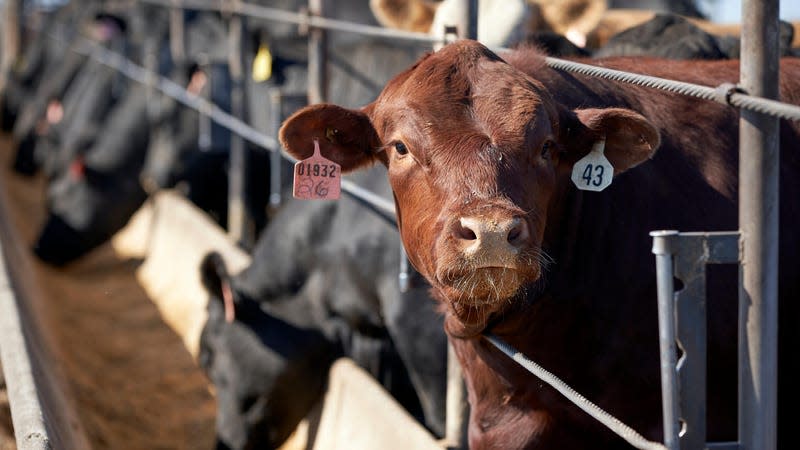Industrial Meat and Dairy Is Destroying the Planet

The world’s largest meat and dairy companies are responsible for more than 10% of all global methane emissions from livestock, with some singular companies emitting as much or more methane than many individual countries, including Russia, Germany, and Australia, a new report finds. The report, released this week from the Institute for Agriculture and Trade Policy and the Changing Markets Foundation, does a lot of math on food giants like JBS, Tyson, Nestle, and Danone, finding that just 15 meat and dairy companies are responsible for 3.4% of global methane emissions from human activity.
Overall, the report finds, these companies are emitting 734 million tonnes of CO2 equivalent each year—higher than the annual emissions of Germany—while their methane footprint from agriculture is around 80% of the European Union’s entire methane footprint.
Read more
“Agricultural emissions are quite concentrated within a handful of huge meat and dairy corporations who are responsible for a big chunk of this problem through their globalized supply chains,” Nusa Urbancic, the Campaigns Director for the Changing Markets Foundation, told Earther in an email. “This study shows that methane emissions from industrialized animal agriculture should be high on the governments’ priority list.”
Methane stays in the atmosphere for a much shorter time than carbon dioxide, but it’s more intense while it’s up there, making it an increasingly worrisome factor in the world’s runaway warming. Cows are a particularly problematic source of methane emissions due to the process of enteric fermentation—their digestive mechanics that result in some heavily greenhouse gas-laden burps. Thanks in part to the explosion of animal agriculture in recent decades, cattle farming is now responsible for 9% of total global methane emissions. In recent years, global leaders have increasingly stressed the need to get methane emissions under control, and quickly, in order to get overall warming down.
To put together the report, researchers used data on milk intake from 10 of the world’s top dairy companies and slaughter numbers—the number of animals killed per year—from some of the world’s top meat distributors. The authors then used regional meat production estimates, regional average greenhouse gas emissions intensity data, and milk production estimates from a UN agricultural assessment model to calculate the methane emissions of each company.
A lot of these numbers are hard to find, and much of the research relied on self-reported data from the companies themselves. During the report’s research phase, the authors asked the 15 companies for regional breakdowns of milk or slaughter data; only four companies responded.
“It is very challenging to get any data from these companies,” said Urbancic. “There is very little in the public domain, and especially for the meat companies we had to plough through all their annual, sustainability and investment reports to get any information on their operations.”
Three of the five meat companies—including JBS and Tyson—did not publish their slaughter data, so to estimate the numbers of animals they process each year, the report uses slaughter processing rates, or the number of animals their facilities can slaughter, to estimate how many animals they’re killing per year.
There’s a lot of ambiguity here, given how little data is publicly available—which in itself is a red flag that more transparency is needed to get a better grip of how much damage these companies are actually inflicting on the planet. The initial numbers provided by the report are still staggering. According to the report’s methodology, JBS, the largest meat producer in the world, has a methane footprint larger than those of Italy, Spain and the UK combined; Tyson Foods, meanwhile, has a methane footprint larger than Russia’s. (We reached out to several of the companies named in the report and will update this article if they respond.)
There are lots of industries that need more regulation to curb their methane emissions (looking at you, oil and gas companies). But as this report highlights, industrial agriculture has a large part to play in our current methane problem. The industry is also building defenses to its methane emissions that policymakers should be aware of as they construct responses.
“Given that we are in a climate emergency, which is already affecting farmers everywhere, governments must urgently act and put in place a comprehensive set of regulations, which should range from climate targets for the agricultural sector and reform of existing harmful agricultural subsidies.” said Urbancic. “However, it will be critical that the burden for emissions reduction rests on corporations that shape and drive the supply chain. Farmers within and outside these corporate supply chains must be supported to play a critical role in a sequenced, deliberate and just transition out of mass industrial livestock production towards agroecological systems that are healthy for the planet and people.”
More from Gizmodo
The Best Shortcuts On Mac: Snap Windows, Text to Speech, and More
How to Delete Your Twitter Account If Elon Musk Was Your Last Straw
Sign up for Gizmodo's Newsletter. For the latest news, Facebook, Twitter and Instagram.

